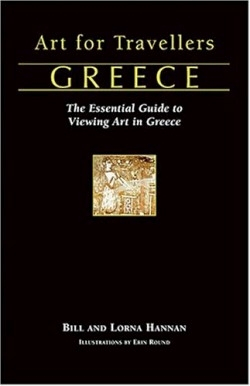Art for Travellers Greece
The Essential Guide to Viewing Art in Greece
Over a century ago the Parthenon lost its marbles to Britain’s Lord Elgin. Today, as the fumes of modern Athens work to complete the destruction, the ancient ruins remain the essential starting point for an art lover’s tour of Greece. Towering above the city, the Parthenon is “a stark symbol of a glorious past,” a past that the authors thoroughly and intimately embrace in their profuse and consummate guide to art in Greece.
Systematically, the Hannans lay out eight different trails: three in and around Athens; four more to Delphi, Corinth, Olympia, and Thebes; plus an eighth “trail” to the islands of Crete and Santorini. Collectively, the trails offer a range and depth of art that few travellers experience. Each trail takes two or three days—five for the islands. At least three weeks would be needed to do it all. The entrance ticket for Delphi alone is for two days, and the authors advise that a single visit to the National Archeological Museum in Athens does not do it justice.
Like the Hannans’ earlier volume, Art for Travellers: France: The Essential Guide for Viewing Art in Paris and its Surrounds, this guidebook is earnest and exhaustive, taking the connoisseur on a room-by room, piece-by-piece, limb-by-missing-limb excursion. The extreme aficionado excepted, travellers will want to integrate the art tour with activities of a more general interest. With the view that it’s impossible to isolate the art, the Hannans provide helpful digressions into other themes, such as history and literature. Homer’s epics, for example, are said to have provided nineteenth-century archeologists with clues to the location of several ancient sites.
Inappropriate restoration is an issue the Hannans barely touch on. Knossos, the site of the ancient Minoan civilization on the island of Crete, was the object of a controversial reconstruction—rebuilt columns, repainted frescoes, a recreation of the way life might have been. The Hannans limit their criticism to a restrained observation that the restoration, done a century ago, would not be done today.
Exuding a special veneration for objects that survived for thousands of years buried in a few inches of dirt, the Hannans suggest that such prizes challenge the modern myopic notion of history. Whether taking the entire art lover’s circuit, a trail or two, or merely “armchairing” it, one feels the influence of Greek art through the millennia—how Minoan culture permeated the Mycenaean world, how Classical culture shaped that of the Roman Empire, and how the legacy of the art of Greece permeates Western culture today.
Reviewed by
Rob Mitchell
Disclosure: This article is not an endorsement, but a review. The publisher of this book provided free copies of the book to have their book reviewed by a professional reviewer. No fee was paid by the publisher for this review. Foreword Reviews only recommends books that we love. Foreword Magazine, Inc. is disclosing this in accordance with the Federal Trade Commission’s 16 CFR, Part 255.

